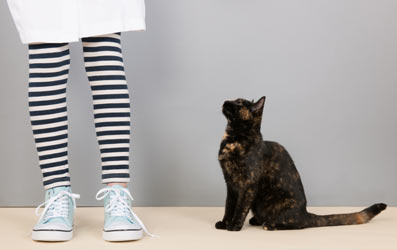Clicker Training for Cats: Sit

Many people believe that it's impossible to teach a cat to come or to sit. These are dog tricks, surely! But it is entirely possible to teach these things to your cat, and they will help you both to enjoy your relationship more. Clicker training cats to sit and stay is not only possible, it's fun for you and your cat.
Teaching your cat how to sit on cue is a foundation behavior that will come into play in many situations. From having your cat stay put when needed to redirecting her away from inappropriate behavior, the sit command will give your cat something positive to do and help her to focus on you instead of a stressful or exciting situation.
Sitting is a natural behavior for your cat but doing so on cue is a different story. Most cats would rather come and rub on you. Some might come and investigate what you are up to and then leave again.
Useful Situations for Sitting
There will be many times when you will need your cat to sit. Not only is it a prelude to the sit/stay command and other behaviors, but it is also a means of reducing your cat's stress during new or stressful situations such as these:
- Getting a health check
- Learning to stay off of counter tops
- Meeting new people
- Grooming and bathing
- Making sure she doesn't escape outside when doors are open
Targeting Into Position
Once your cat has a full understanding of the meaning of the clicker and the target spoon, as described in this article, you can use the target spoon to guide your cat into a sitting position, then click and reward her.
- Begin the training by having your cat target on the spoon. When she puts her nose near it to sniff the food on the spoon, click and reward her.
- During the next attempt, hold the target spoon just over your cat's head. When she looks up at it, click and reward her.
- Repeat this step 2-3 more times until your cat readily puts her head up while targeting on the spoon.
- Next, bring the spoon back further over her head so that she has to lower her rear end in order to follow the spoon with her eyes. As she does this, click and reward her.
- Gradually require more and more of an actual sitting position prior to each click and reward.
Be sure not hold the target spoon so high over your cat's head that she feels that she must rise up into the air in order to target on it. Keep it just a few inches over her head so that she shifts her weight onto her haunches as she follows the spoon.
Come and Sit Commands
Eventually, you will want your cat to come to you and also sit when she arrives. This keeps her near you for other purposes, such as more training exercises or whatever you need to do with her.
Up to this point, you have had to use the target spoon to gain your cat's attention for both the come and the sit commands. Now it's time to add another cue for when your cat can't see you-tapping a surface. Once she's nearby, you can use the target spoon to lure her even closer and into a sitting position.
- Begin by using the target spoon as a lure while your cat is within sight of you. Tap a hard surface with your free hand as you tell your kitty to come.
- After several repetitions, your cat will associate the hand-tap with the verbal command to come. Test this by moving further and further away from your cat with each repetition. If she should not come to you directly from a certain distance, move closer and try again. Repeat each distance as many times as is necessary for your cat to come to you consistently from that distance before moving further away.
- Once your cat has learned to come to a tap, lure her into a sitting position with your target spoon. Always click and reward your cat the moment that she attains the proper sitting position.
Training sessions generally work best when they are kept to five to six repetitions. If your cat acts frustrated or becomes disinterested, give her a break and try again later.
Never use punishment to try and train your cat! Your cat may learn to be afraid of you, hide, become aggressive, or develop negative behaviors if she is stressed because of the punishment.
Throughout the training process, offer lots of enthusiastic praise and petting immediately after a training session. Many cats enjoy your touch as much as they enjoy the food rewards and, eventually, the praise may be all that is required to reinforce the behavior that you're looking for.
You May Also Like These Articles:
Clicker Training for Cats: An Overview
How to Train Your Cat to Walk on a Leash
Training Your Cat To Use A Pet Carrier
Training Your Cat To Stay Off The Kitchen Counter
Clicker Training for Cats: Sit
Notice: Ask-a-Vet is an affiliated service for those who wish to speak with a veterinary professional about their pet's specific condition. Initially, a bot will ask questions to determine the general nature of your concern. Then, you will be transferred to a human. There is a charge for the service if you choose to connect to a veterinarian. Ask-a-Vet is not manned by the staff or owners of CatHealth.com, and the advice given should not delay or replace a visit to your veterinarian.





